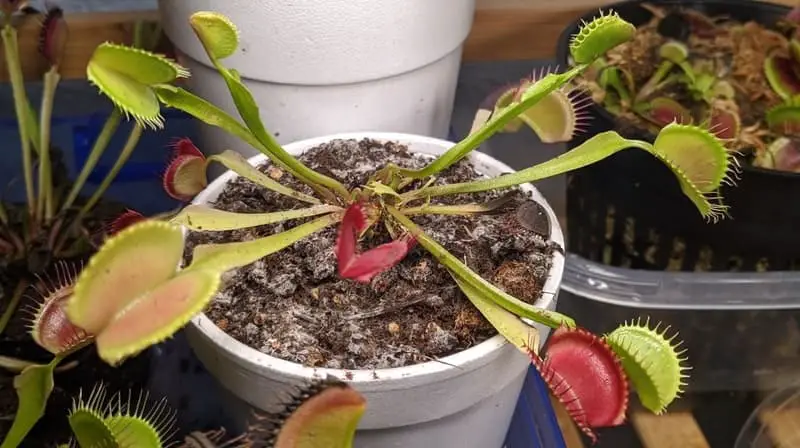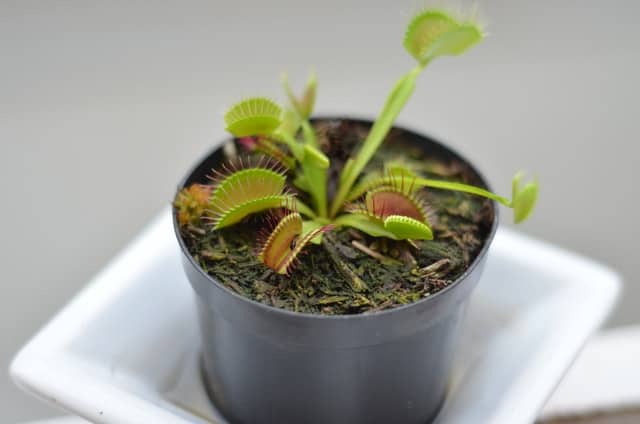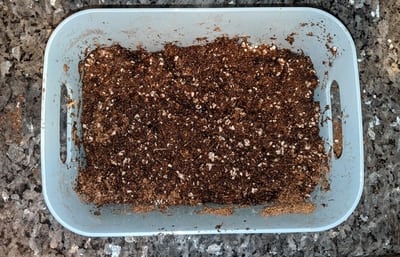My Venus flytraps have suffered from mold issues in the past. After caring for them for multiple seasons, I have learned how to eliminate and prevent mold all together.
White fuzzy mold does not kill Venus flytraps. However, the mold does affect the plant’s growth and can potentially expand to surrounding plants. Adjusting moisture levels and providing strong lighting can eliminate mold issues.
Even though white mold does not kill Venus flytraps, other types of mold do. And guess what? They all develop under very similar conditions.
Mold Issues in Venus Flytrap
The presence of mold in your plant has many downsides. It is unattractive, it can continue to spread to other plants, and it is a clear sign of excessive moisture (which can be very harmful to your plant). White mold is a type of fungus that consumes dead matter. The mold won’t kill your plant directly, but the conditions where the mold developed can affect your plant significantly.

Venus flytraps benefit from high humidity environments. They thrive in humid soil. But, the presence of white mold is a clear sign of excessive humidity. The plant is likely to be overwatered. To resolve this issue, you must adjust your watering technique and increase sunlight exposure.
Venus flytraps need to be watered often, but they do not require excessive watering (here is a guide on watering that can help you use the optimal amount) (here is a guide on watering that can help you use the optimal amount). These plants like to live in humid soil. However, they do not thrive in damped conditions. Avoid overwatering by never flooding the ground. Instead, water until the soil is moist. Then, wait to water again until the soil is less humid.
Exposure to bright direct sunlight can also help reduce the moisture level in the environment.
How to Eliminate Mold from the Soil
There are a few different options to remove mold from Venus flytrap soil:
- Manual removal
- Bright light exposure
- Repotting
First, attempt to remove the white mold by manually removing the white fuzz from the soil. You can remove the upper layer of the soil and refill the pot with fresh soil. After removing the mold, you must follow the instructions in the next section to prevent it from growing once again.
You can also try placing your plant under a bright light for a few days or weeks. For example, bright direct sunlight will lower the moisture level and kill the mold. The extra lighting you provide will benefit the plant as long as the temperature is not excessive. Avoid placing your plant under direct sunlight if the temperature exceeds 95 F (35 C).
Finally, you can repot your Venus flytrap for more extreme situations and set it in brand new soil. Repotting the plant can weaken it, but it will recover in a couple of weeks. Since repotting Venus flytraps without harming them can be challenging, I made an article covering repotting tips and considerations. Make sure to check it out.
When you repot a Venus flytrap due to mold issues, you must clean the container thoroughly and employ only fresh soil. Also, you can utilize sulfur-based fungicide to secure that the mold won’t reappear.
Regardless of what method you employ to eliminate the mold from your Venus flytrap, you must follow the mold prevention instructions in the next section. Removing the mold won’t solve your problem. Fixing your setup and providing a suitable growth environment for your plant will eradicate any related issues.
Prevent Mold in Venus Flytraps
Now, it is time to learn how to prevent any mold issues. These instructions will help you avoid fungus, which can lead to root rot and other problems.
Master the Watering Process
When watering a Venus flytrap, always monitor the moisture level in the soil. After watering the plant, palpate the ground. The soil should be humid but not soaking wet.
An excellent method to avoid overwatering your plant is employing a water tray for watering. In this method, you water the plant from the bottom by placing the plant pot in a tray and adding water to the tray (not to the plant). The water in the tray causes a humid yet not flooded environment. For best results, only fill the water tray with 1 inch of water. And wait until the tray has just dried up before refilling.

Schedule a Yearly Repotting
Repotting Venus flytraps every year helps prevent rotting and fungus issues. As time goes by, the soil in your plant’s pot gets compressed. Even though Venus flytraps can continue to grow in the same soil for years (they are very resilient plants!), it is not optimal. Repotting your plant once a year prevents soil compression and stimulated growth. As a result, water will continue to flow, and the plant won’t sit in standing water for long periods.
Choose Soil with Drainage
For the soil, employ a mixture of moss with a draining agent. For example, I usually use a 1:1 mix of peat moss and perlite. You can also opt for a combination of sphagnum moss and sand. Besides the moss portion, always employ sand or perlite. These elements break up the soil, encourage water drainage, increase aeration, and prevent soil compresion.
If you are unfamiliar with the soil requirements or are just looking for recipes, I recommend reading this article. It covers all you need to know about Venus flytrap soil.

Avoid Sporadic Misting
Venus flytraps thrive in humid environments. However, they can adapt to relatively dry climates. If you live in an arid environment, you can consider misting your plant. But you must do it consistently. Consider using an automatic mister to increase the humidity in the environment continuously. Avoid using manual misters to spray your plant sporadically.
Casually misting your plant won’t provide much of a benefit. Instead, it can cause excessive moisture in the soil surface. And this excess of humidity can lead to mold.
Adjust Watering During Dormancy
In the winter months, Venus flytraps undergo a dormancy process. The resting period is long (2-3 months) but necessary. During dormancy, Venus flytraps stop growing. As a result, they do not require as much exposure to light. Also, they reduce their water consumption. When Venus flytraps are dormant, you must adjust the amount of water you provide.
Employ Bright Sunlight/ Light
Exposure to bright artificial or natural light is almost always the answer for Venus flytraps. Regardless of any mold issues. You must always provide adequate light exposure. Optimally, Venus flytraps should receive 12 hours of light; however, they can live healthy with at least 6 hours of sunlight.
Sunlight is more effective in promoting growth and eliminating any mold issues due to its intensity. If possible, consider growing your plant outdoors. It is possible to grow Venus flytraps indoors under artificial light, but it is more challenging.
Final Thoughts
White mold is not a plant killer. There is no need to be excessively alarmed after spotting white mold in a Venus flytrap. Still, if your plant has mold, it is best to eliminate it. The lack of white mold is not a guarantee that the growing conditions are optimal. However, the presence of white mold is a sign of poor growing conditions.
I hope you found the tips in this article useful. Growing Venus flytraps can be a challenge. Mold is just one of the issues that can arise. To ensure you are successful at growing Venus flytraps, I encourage you to read this article on Venus flytrap Care. It is a complete guide on growing these remarkable plants.

